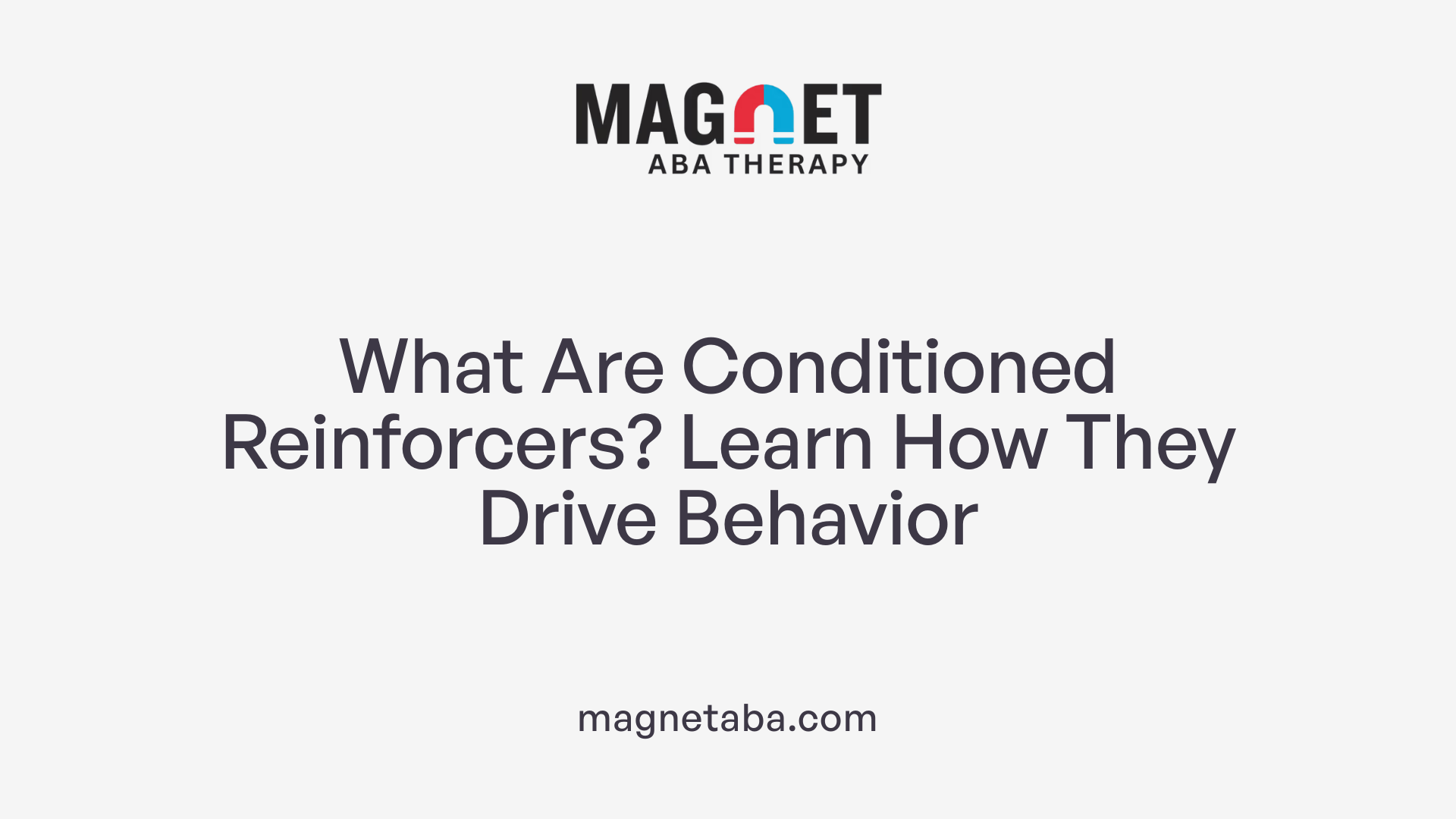Introduction to Reinforcement in ABA
Applied Behavior Analysis (ABA) utilizes various reinforcement strategies to modify and promote desirable behaviors. Central to these strategies is the concept of reinforcers, which motivate behaviors. Among these, conditioned reinforcers play a vital role due to their adaptability and powerful influence on behavior. To appreciate their importance, it is essential to understand what they are, how they differ from other reinforcers, and how they are practically applied in ABA interventions.
Defining Conditioned Reinforcers in ABA

What are conditioned reinforcers in Applied Behavior Analysis (ABA)?
Conditioned reinforcers, also known as secondary reinforcers, are stimuli that have gained the ability to reinforce behavior through past learning experiences. Unlike unconditioned reinforcers—such as food, water, or warmth—that naturally promote survival and are inherently reinforcing, conditioned reinforcers require an individual to learn their value.
This learning process involves pairing a neutral stimulus with a primary reinforcer until the neutral stimulus itself becomes reinforcing. For example, a token used in a token economy system initially has no value but becomes a powerful reinforcer after being associated with preferred items or activities.
How do conditioned reinforcers work?
The reinforcing power of conditioned stimuli comes from their association with unconditioned reinforcers or other already established conditioned stimuli.
Through repeated pairings, these stimuli come to signify access to desired outcomes, which motivates the individual to engage in specific behaviors. For instance, praise or social approval can become effective reinforcers when linked repeatedly with positive outcomes.
The role of individual learning history
Each person's unique learning history influences what functions as an effective conditioned reinforcer. Cultural context, personal preferences, and previous experiences shape which stimuli acquire reinforcing properties. As a result, what is a powerful reinforcer for one person may not be for another.
Examples of conditioned reinforcers
- Tokens or points: Used in various reinforcement programs, eventually exchangeable for other rewards.
- Praise or social approval: Gained through consistent positive interactions.
- Money: A learned reinforcer because of its association with obtaining food, shelter, and other primary needs.
- Objects or activities: Toys, technology, or music that have been paired with reinforcement.
Why are conditioned reinforcers important in ABA?
In applied settings, especially with children or individuals with developmental disabilities, natural reinforcers might be limited or inaccessible. Conditioned reinforcers expand the range of behavior management tools, enabling practitioners to reinforce desired behaviors effectively. They can be tailored to individual interests and learned preferences, making interventions more engaging and successful.
Differentiating Conditioned Reinforcers from Other Reinforcers
What is the difference between conditioned reinforcers and other types of reinforcers, such as unconditioned or primary reinforcers?
Conditioned reinforcers, also known as secondary reinforcers, are stimuli that acquire their reinforcing power through learning and associations with primary reinforcers. These reinforcers are not inherently reinforcing but become valuable because of their connection to primary reinforcers via experience. Examples include praises, tokens, money, and social approval.
Primary reinforcers, on the other hand, are naturally reinforcing because they fulfill biological needs. They do not require learning or experience to be effective. Common primary reinforcers include food, water, warmth, sexual stimulation, and relief from pain or discomfort.
The main distinction lies in their origin and necessity for learning. Primary reinforcers are innate, necessary for survival, and work without prior experience. Conditioned reinforcers require a learned association with primary reinforcers, making their reinforcing properties dependent on the individual’s history of learning.
Another important difference is their susceptibility to satiation. Primary reinforcers can lose effectiveness if a biological need is satisfied—like feeling full after eating. Conditioned reinforcers generally maintain their effectiveness over time, especially if they are generalized reinforcers like money, which can be exchanged for various primary reinforcers.
In summary, primary reinforcers naturally motivate behavior due to biological functions, while conditioned reinforcers gain their power through learned pairings, offering a flexible way to influence behaviors, particularly when primary reinforcers are less accessible or effective.
Examples of Conditioned Reinforcers in Practice
 Conditioned reinforcers are widely used in Applied Behavior Analysis (ABA) to promote positive behaviors, especially when primary reinforcers like food or water are not feasible or sufficient.
Conditioned reinforcers are widely used in Applied Behavior Analysis (ABA) to promote positive behaviors, especially when primary reinforcers like food or water are not feasible or sufficient.
Common examples used in ABA settings
Some of the most typical conditioned reinforcers include tokens, points, praise, grades, badges, certificates, and social approval. These stimuli do not have innate reinforcing properties but become motivating after being repeatedly associated with primary reinforcers such as food, attention, or other rewarding outcomes.
For example, a child might earn a token after completing a task. This token can then be exchanged later for a preferred activity or item, serving as a bridge to reinforce the behavior initially. Similarly, social praise, like saying "Good job!" or offering a smile, gains reinforcing power through its consistent pairing with positive interactions.
Symbols of achievement like trophies or medals are also conditioned reinforcers because their value is learned through their association with accomplishments and rewards.
How these stimuli are conditioned and used to reinforce behaviors
The process of conditioning involves pairing the neutral stimulus—such as a token, praise, or badge—with primary reinforcers or other reinforcing stimuli. This pairing is often repeated until the neutral stimulus itself begins to motivate behavior independently.
Two common methods are used:
- Stimulus Pairing: The neutral stimulus is repeatedly presented alongside primary reinforcers without requiring the individual to respond. This method was tested in studies with preschool children, showing limited success.
- Response–Stimulus Pairing: The neutral stimulus is presented contingent on the target response, meaning the individual receives the stimulus specifically after performing the desired behavior. This method has been more successful in establishing conditioned reinforcers.
Once conditioned, these stimuli can be used flexibly across different behaviors, settings, and individuals, making them highly versatile tools in ABA.
Practical significance
These conditioned stimuli are especially valuable as they can be tailored to individual preferences and are less susceptible to satiation than primary reinforcers. For example, a token system allows a teacher to reinforce many behaviors without exhausting the primary resources, like food or attention.
Moreover, conditioned reinforcers are crucial for promoting behaviors in individuals who may have limited access to natural reinforcers or specific needs, such as children with autism, making behavioral interventions more effective and sustainable.
Establishing and Implementing Conditioned Reinforcers in ABA
How are conditioned reinforcers established and used in ABA interventions?
Conditioned reinforcers, also known as secondary reinforcers, are established through a learning process where a neutral stimulus is repeatedly paired with an unconditioned or primary reinforcer. Over time, the neutral stimulus gains reinforcing properties, meaning that it can motivate and reinforce behavior on its own (Cooper, Heron, and Heward, 2007; 2020).
In Applied Behavior Analysis (ABA), this process typically involves pairing a neutral object or stimulus—such as a token or a symbolic item—with a primary reinforcer like food, praise, or access to preferred activities. For example, a token in a token economy system initially holds no value. However, after being paired with tangible reinforcers multiple times, it becomes a conditioned reinforcer that can be exchanged for the backup reinforcers.
These reinforced associations make conditioned reinforcers highly adaptable and especially useful in settings where primary reinforcers are not practical or are delayed. They are particularly effective for motivating behavior in individuals who have limited access to natural primary reinforcers, such as children with autism.
The use of conditioned reinforcers enhances the flexibility of reinforcement strategies, allowing for reinforcement to be administered more efficiently and with less interference in daily routines. In addition, their reinforcing power can be tailored to individual preferences and cultural contexts, increasing their overall effectiveness.
Role of pairing and reinforcement schedules
The strength of conditioned reinforcers depends significantly on the consistency and contingency of pairing. Typically, repeated pairings of stimuli with primary reinforcers strengthen the association. Reinforcement schedules—such as continuous or intermittent reinforcement—also influence how effectively a conditioned reinforcer motivates behavior.
Research shows that response–stimulus pairing, where the conditioned stimulus (e.g., praise, tokens) is presented contingently on target behaviors, is more effective than simply presenting the stimulus noncontingently. This contingency-based pairing makes the conditioned reinforcer more reliable, increasing the likelihood of behavior repetition.
Implementing a systematic reinforcement schedule helps maintain motivation over time and prevents satiation. For example, initially using continuous reinforcement to establish the conditioned reinforcer, then shifting to intermittent schedules, supports durable learning and behavior change.
| Establishment Method | Reinforcement Schedule | Effective for | Description |
|---|---|---|---|
| Response–stimulus pairing | Contingent reinforcement | Building strong associations | Pairing praise, tokens, or social approval with target responses ensures they serve as effective conditioned reinforcers |
| Noncontingent pairing | Variable reinforcement | Initial learning phase | Presenting stimuli alongside primary reinforcers without direct contingency, but often less effective for long-term reinforcement |
| Multiple pairing | Consistent reinforcement | Maintaining behavior | Repeated pairs solidify the reinforcement relationship over time |
Understanding how to effectively establish and implement conditioned reinforcers is essential in ABA for creating motivating and sustainable behavior change strategies.
Significance of Conditioned Reinforcers in ABA Education and Therapy

Why are conditioned reinforcers significant within ABA therapy and education?
Conditioned reinforcers play a crucial role in Applied Behavior Analysis (ABA) therapy and educational settings. These stimuli are not inherently reinforcing but acquire their value through learning and association with primary reinforcers, such as food or comfort.
One of their main advantages is their ability to sustain motivation over time. Since primary reinforcers like food are limited, especially in therapeutic environments, conditioned reinforcers like praise, tokens, or points can serve as effective alternatives.
They act as signals that reinforce specific behaviors, guiding learners towards desired responses. Research supports that conditioned reinforcers can influence how strongly and quickly behaviors are reinforced, making therapy more efficient.
Moreover, these reinforcers are highly adaptable. They can be tailored to individual preferences, such as favorite toys, social attention, or electronic devices, which increases their effectiveness.
In addition, conditioned reinforcers are easily delivered and can be used across different environments, promoting consistency and generalization of learned behaviors. This flexibility is especially beneficial for children with autism who may have limited access to natural reinforcers.
Summary table of importance:
| Aspect | Explanation | Example |
|---|---|---|
| Motivation sustenance | Maintains learner engagement over time | Tokens, praise |
| Practicality | Easier to administer than primary reinforcers | Praise, points |
| Personalization | Can be tailored to individual preferences | Favorite music, social approval |
| Generalization | Used across multiple settings | Tokens accepted in various locations |
| Behavior maintenance | Supports long-term learning | Social praise after tasks |
Overall, conditioned reinforcers significantly enhance the quality and effectiveness of ABA therapy and educational programs by providing flexible, motivating, and sustainable reinforcement options. Their understanding and appropriate use can lead to better learning outcomes and more consistent behavior change, especially among children with autism and other developmental challenges.
Final Thoughts on Conditioned Reinforcers in ABA
Understanding conditioned reinforcers is essential for effective behavioral intervention. Their ability to be tailored to individual preferences and their strength in maintaining motivation make them indispensable tools in ABA. By establishing and effectively utilizing these reinforcers, clinicians and educators can foster enduring behavior change and promote skill development in diverse populations, especially children with autism. As research continues to uncover new methods for conditioning and applying reinforcers, their significance in shaping behavior remains a cornerstone of behavior analytic practice.
References
- Conditioned Reinforcer - Study Notes ABA
- B.7 Unconditioned, Conditioned, and Generalized Reinforcers
- 6e.B-7: Identify and distinguish among unconditioned, conditioned ...
- aba terms-classifying reinforcers - Autism Center for kids
- Understanding Unconditioned Reinforcers & Unconditioned Punishers
- [PDF] Conditioned reinforcer A stimulus that becomes an effective ...
- Classifying Reinforcers - brightpathbehavior.com











